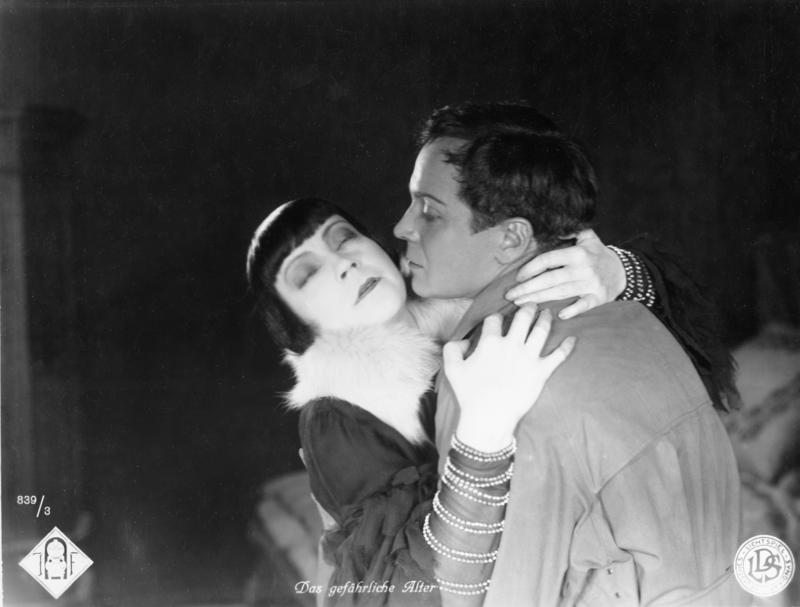enda
Film
The Dangerous Age
Eugen Illés, Germany, 1927
78 min.FeatureDrama, Erotic melodrama, Adaptions

The gorgeous 40-year-old Elsie Lindtner lives in a beautiful house, and is married to a respectable university professor. And yet, there’s something that nags her. She’s about to reach “the dangerous age”, when beauty begins to fade and boredom kicks in. She falls in love with a younger man and divorces her husband, but ends up hiding away in a country house where she can age in secret.
The film is based on Danish Karin Michaëlis’s great and scandalous breakthrough from 1910. With Den farlige Alder, Michaëlis put the issue of menopause on the table for the first time, and did so in a form that resonated throughout Europe. With its modern view of women’s desires, the novel was, in many ways, ahead of its time. Eugen Illés’s film adaptation interprets the topic freely, using psychological nuances and dashes of both comedy and morality. Asta Nielsen glows enigmatically and charismatically as Elsie Lindtner, and Illés manages to remain true to the core of the novel and unite comedy and tragedy in a popular film about age and longing.
The role of the beautiful professor’s wife, who fears decay and oblivion, became Asta Nielsen’s penultimate film role. At the time, she was 46 years old and bestows the role with the broad experience of a mature woman and actress.
Den farlige Alder was first filmed in Denmark in 1911 and was heavily censored and banned in several places. The version directed by August Blom, relates quite freely to the novel’s original and tells the narrative as a mother/daughter jealousy drama. August Blom’s version can also be watched here on our website.
The film is based on Danish Karin Michaëlis’s great and scandalous breakthrough from 1910. With Den farlige Alder, Michaëlis put the issue of menopause on the table for the first time, and did so in a form that resonated throughout Europe. With its modern view of women’s desires, the novel was, in many ways, ahead of its time. Eugen Illés’s film adaptation interprets the topic freely, using psychological nuances and dashes of both comedy and morality. Asta Nielsen glows enigmatically and charismatically as Elsie Lindtner, and Illés manages to remain true to the core of the novel and unite comedy and tragedy in a popular film about age and longing.
The role of the beautiful professor’s wife, who fears decay and oblivion, became Asta Nielsen’s penultimate film role. At the time, she was 46 years old and bestows the role with the broad experience of a mature woman and actress.
Den farlige Alder was first filmed in Denmark in 1911 and was heavily censored and banned in several places. The version directed by August Blom, relates quite freely to the novel’s original and tells the narrative as a mother/daughter jealousy drama. August Blom’s version can also be watched here on our website.
| Original title | Das gefährliche Alter |
|---|---|
| Danish title | Den farlige Alder |
| Director | Eugen Illés |
| Screenplay | Bobby E. Lüthge |
| Based on | Efter Karin Michaëlis' roman. |
| Director of Photography | Johannes Männling |
| Production designer | Gustav A. Knauer |
| Appearance | Bernhard Goetzke, Asta Nielsen, Walter Rilla, Hans Adalbert von Schlettow |
| Production country | Germany |
| Technical info | 2598 meter, 35 mm, Normal, Black/white, Silent |
| Danish theatrical release | 17.01.1928 |
| Cinemas | Det lille Teater |
Companies |
|
| Production company | Gmbh Illés Film |
|
|
|
Direction |
|
| Direction | Eugen Illés |
|
|
|
Script |
|
| Script | Bobby E. Lüthge |
|
|
|
Cinematography |
|
| Cinematography | Johannes Männling |
|
|
|
Production design |
|
| Production design | Gustav A. Knauer |
|
|
|
Appearance |
|
| Richard Lindner | Bernhard Goetzke |
| Elsie, Lindners hustru | Asta Nielsen |
| Jörgen, student | Walter Rilla |
| Axel, student | Hans Adalbert von Schlettow |
| Magna Rothe, studine | Maria Paudler |
| Wellmann | Hans Wassmann |
| Lily, Wellmanns hustru | Trude Hesterberg |
| Torb, kokkepige | Lucie Höflich |
|
|
|
Reviews and articles
On the library you can find these articles and revies and other material about the film.
| Type | Source | Author | Date |
|---|---|---|---|
| Artikel | |||
| Program - stumfilm & mikro |